Features of shading nets for greenhouses
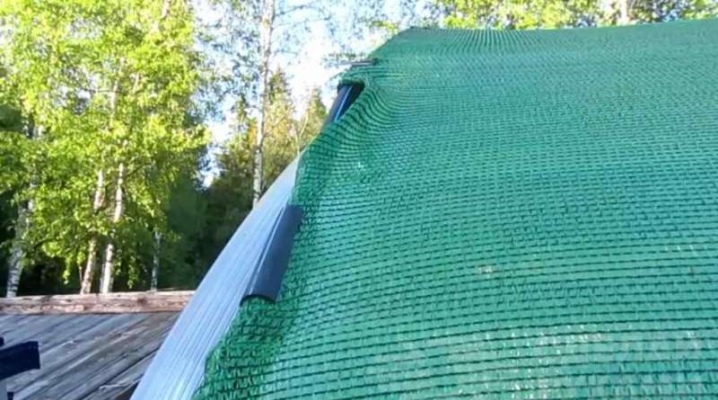
Shading net for greenhouses and sheds - a unique material in demand with a wide range of applications. From this article you will learn what it is, what it is used for. In addition, we will show you how to select and install it correctly.
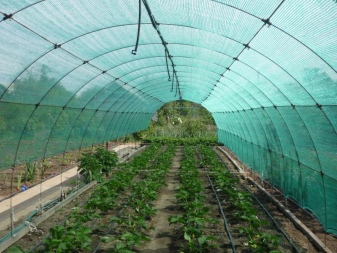
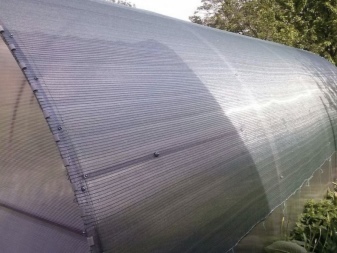
Description and purpose
Light shading mesh for greenhouses - a web of artificial honeycomb material designed to protect plants and increase yields. It is an alternative to film, displacing wear-resistant polycarbonate, polyethylene and polyvinyl from the domestic market, which do not protect plants from ultraviolet radiation.
It has a honeycomb structure that makes it breathable. It is a lightweight covering material of various widths, lengths, and mesh. Differs in knotted weaving of artificial fiber. It contains a small percentage of foil, thanks to which it can effectively reflect and diffuse the sun's rays.
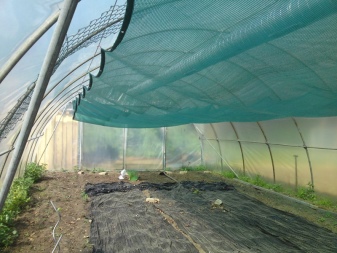
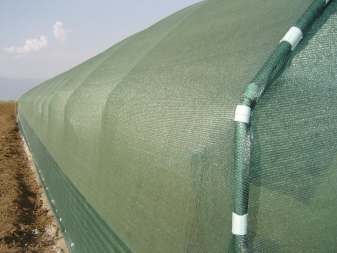
May have different shading rates, so it is suitable for different crops and planting types.
The shading grid has a varied color palette: it can be gray, light green, bright green, pale blue, red. Its density can vary between 35-185 g / m2. Provides for use over the film or tension inside structures.
The mesh does not just hide plants from the sun, it evenly distributes ultraviolet light and dissipates heat over a specific space. This eliminates overheating of plants, reduces the consumption of water used for irrigation. The canvases are ideal for growing vegetables.
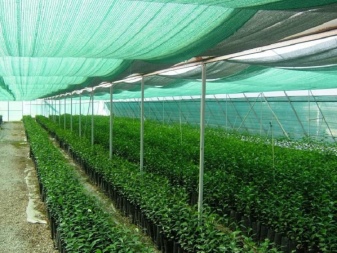
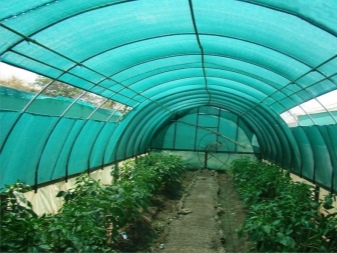
Based on the size of the cellular holes, in addition to sunlight, it can also retain moisture. This allows you to maintain the necessary conditions for the normal growth of plants, to increase the yield (by 10-30% of the usual volume).
The shading net is bought for large farms and compact greenhouses of private houses. The material retains up to 25% of heat when the ambient temperature drops. It is laid inside and outside buildings, used in the open field when arranging a protected space in which shrubs, seedlings, vegetables and fruit trees grow.
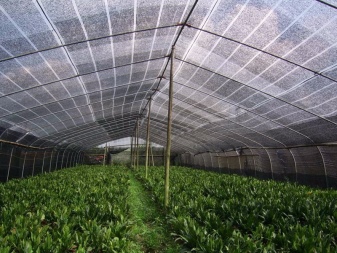
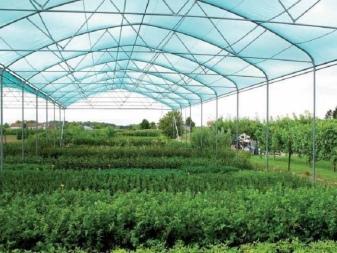
Shading nets are used in commercial activities instead of decorative enclosing structures.
Also, the material is suitable for arranging balconies and loggias of city apartments and private houses. It is used as vehicle sheds. It is used when carrying out the reconstruction of the exteriors of structures.
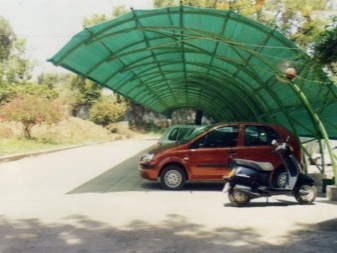
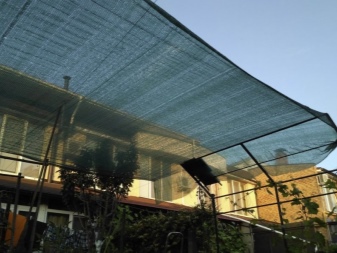
Advantages and disadvantages
Shading mesh for greenhouses and greenhouses has a number of advantages. It is distinguished by:
- environmental safety and absence of toxins;
- ease of maintenance and ease of installation;
- bandwidth variability;
- light weight and resistance to blooming;
- lack of windage when properly installed;
- resistance to fading and stretching;
- ease of folding and packing;
- compactness during transportation and storage;
- creating conditions for accelerated ripening of fruits;
- high resistance to mechanical stress and damage;
- resistance to drying out, decay;
- durability and reasonable cost.
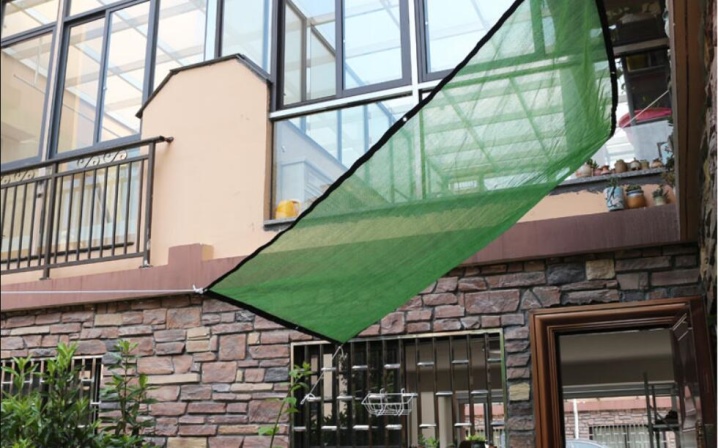
It contributes to the creation of optimal conditions for the growth of greenhouse plants.
It is an effective protection of crops from hail, sunburn, mold, birds. However, with all its advantages, it is not able to maintain elasticity and strength if used at low temperatures.
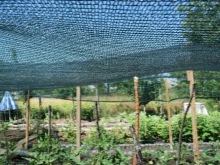
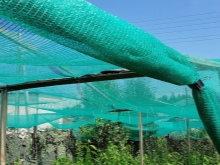
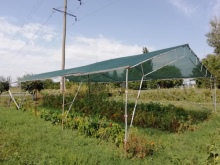
Species overview
The material differs in color, the shape of the cellular holes, the density of the raw materials used and its composition. The shading mesh can be classified according to different criteria.

By the degree of shading
The shading parameters of the material vary from 45 to 90%. The density is selected based on the characteristics of the climatic zone and the culture itself. Sun screens are divided into 2 types: for outdoor and indoor use. In this case, the canvases with the largest cells have a higher light transmission capacity.
Products of the first group have a shading density equal to 70%. They are suitable for growing cabbage, eggplant, tomatoes, lettuce and other greens. The light-protective fabric for shading light-loving crops has a density of 45%.
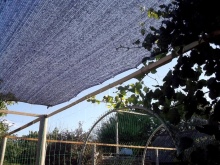
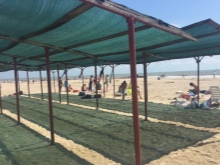
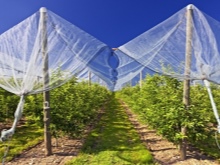
The camouflage mesh has the smallest mesh size. She hides objects from prying eyes.
However, for plants, it is better to take options with medium density values (from 45 to 60-70%, depending on the place of use). If a shading mesh is planned to be used for a fence, the shading rate should be in the range of 80-90%.

By destination
The main field of application of the protective light-shading mesh is agriculture. Reflective, sun-protection, camouflage nets are on sale. Based on the purpose, its use can be based on different principles. It is bought for:
- partial reflection of direct sunlight;
- reducing the amount of thermal radiation;
- conservation of moisture in the soil;
- optimization of the process of photosynthesis;
- uniform distribution of light in the greenhouse;
- dispersion of solar radiation.
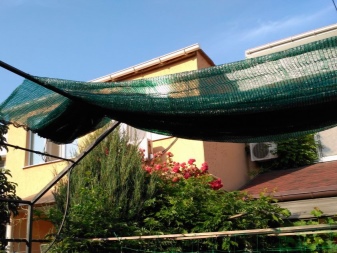
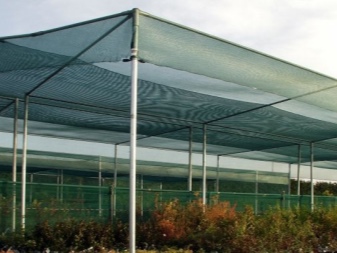
In addition, the landscape of the territory is decorated with nets. They are used to decorate the adjoining territories, with their help they create flower arrangements in places of rest. They decorate summer gazebos, equip flower beds, verandas, terraces. These materials make practical poultry fences.
Also, this material is used to mask unsightly places in the local area.
For example, with its help, the walls of the cabins are masked, decorating them with weaving flowers. In addition, a more dense shading mesh is used to protect scaffolding and to enclose building facades.
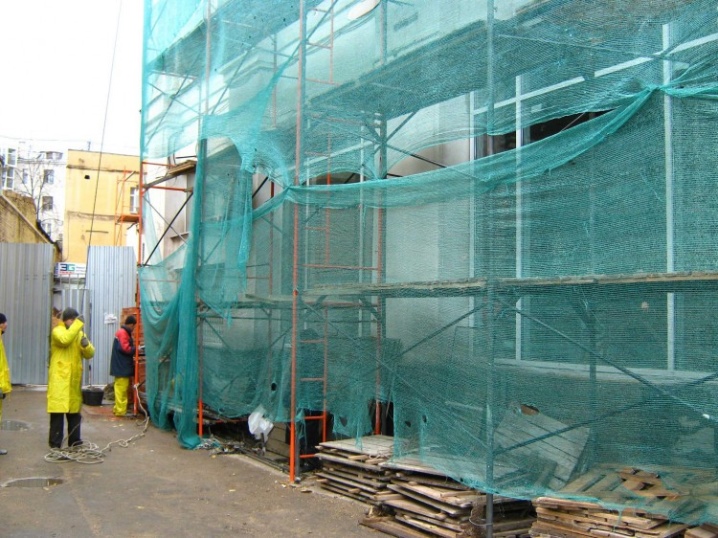
By type of packing
The packaging of the material is varied. The products have a wide range of widths (1-10 m), lengths (up to 100 m). This makes the cover mesh suitable for use in large greenhouses. On sale it is found in the form of rolls and bags. In addition, you can buy it by the footage.
The material is sold wholesale and retail, while there is a diverse range of sizes for products of each density. For example, meshes with a density of 35 g / m2 are sold in packs of 3x50, 4x50, 6x50 m. Material 55 g / m2 can have packing parameters 3x10, 4x10, 6x10, 3x20, 4x20, 6x20, 3x30, 4x30, 6x30, 6x50 m.
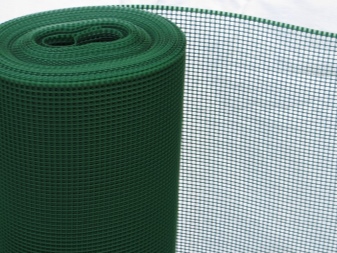
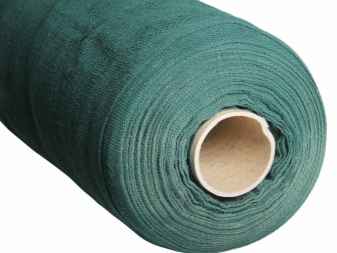
The denser modifications weigh more. However, they can have exactly the same packaging. The most common packaging options range from 3 to 6 m.
In this case, the length of the blade can vary from 10 to 50 m. In addition to the running dimensions, there are products with larger parameters on sale.

Popular manufacturers
Many domestic and foreign companies are engaged in the production of light-shading greenhouse nets:
- AgroKhozTorg is the largest supplier of products for agriculture and construction;
- Aluminet produces a two-layer light-protection net in red and white color, which is characterized by heat resistance and extra strength;
- shading net from the manufacturer Premium-Agro has optimal characteristics, it is suitable for growing zucchini and cucumbers;
- the Tenax SOLEADO PRO network is capable of filtering the amount of ultraviolet rays, the products evenly distribute shading;
- Optima mesh is made of polypropylene fibers, it is highly durable, it is considered reliable protection of plants from gusty winds and weather precipitation;
- the products of the German supplier Metallprofil GmbH are designed to optimize yields, this network is especially strong and durable;
- LLC "Armatex" offers customers a high-quality shading mesh for agriculture, which shelters the crops grown from excessive solar radiation.
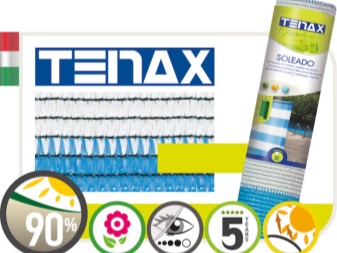
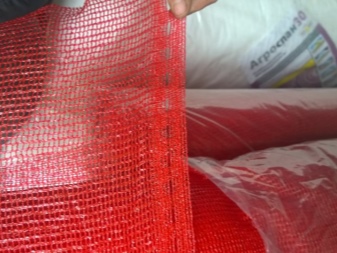
Selection Tips
Before heading to the store behind the shadow grid, you need to study a number of nuances. This will allow you to take a good covering material for specific crops and conditions. For example, they are first determined with the purpose of the purchased material. It is important to choose an option for growing specific types of plants, taking into account the climatic characteristics of the region.
Given the different density of the material, to use the mesh inside the greenhouse, they take material with a shading of 45%. For outdoor applications, a denser mesh is required. If it is bought for landscape decoration, less dense varieties are chosen. Also, a too small mesh cloth is not suitable for weaving cucumbers.
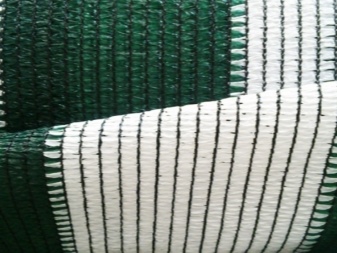
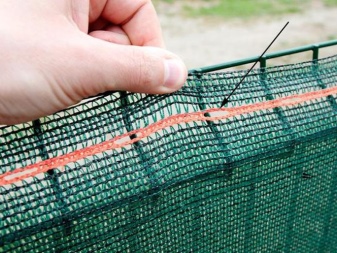
Heat coverings have 60% shading. For fences and hedges, options are taken with a density of 80%. The 90% density shading net is not suitable for plants.
They buy it only for arranging gazebos. You need to buy material taking into account the required size of the shelter.
As for the color, it is better to choose a green canvas. The dark green tone of the material refracts, reflects and absorbs the sun's rays better than other shades. Such a net heats up in the heat, but at the same time protects the plants from the heat.
Blue-green nets are optimal for greenhouses where vegetables are grown year-round. They help to optimize the internal microclimate, maintain it at the desired level. In addition, they provide protection for foliage from burns and mold.
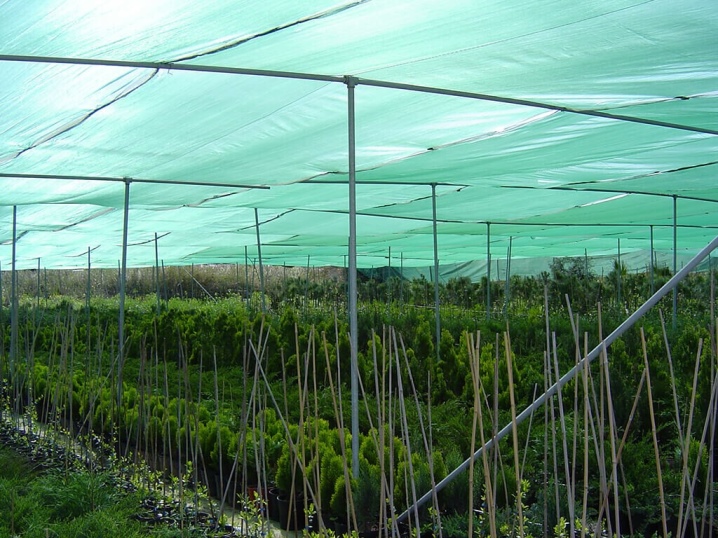
Practice shows that when using a gray-green mesh, the ripening of fruits is accelerated and their size increases. At the same time, more sunlight enters the greenhouse.
Gray nets are used to care for decorative flowers and plants. Gardeners believe that this stretching material promotes the rapid growth of leaves, stems, and bud formation. However, they do not affect fruiting in any way. But they can shelter crops from small frosts.
Red meshes are considered effective for the formation of a large number of ovaries. When using them, plants bloom earlier. However, the color provokes the growth of not only cultivated plants, but also weeds.
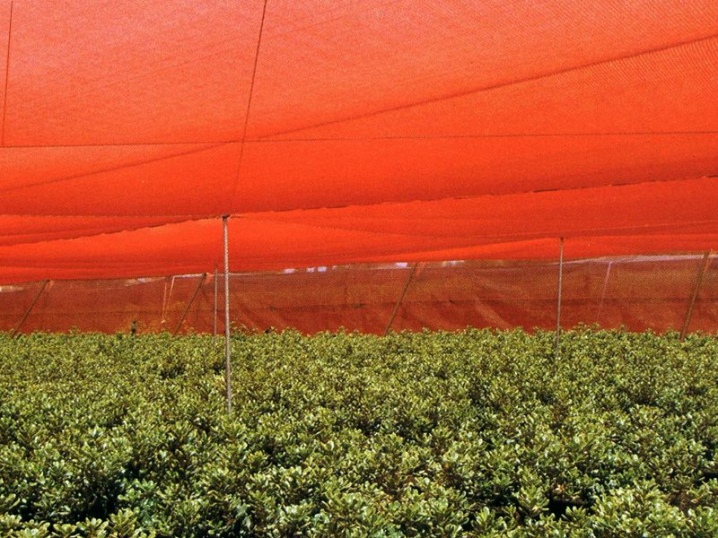
Shadow nets are made from polycarbonate and polymers. Options of the first type are more expensive, have durability and resistance to various negative environmental factors. Polymer analogs are characterized by lower density and low cost. They are cheaper, but also strong and durable. Fabric varieties are impractical.
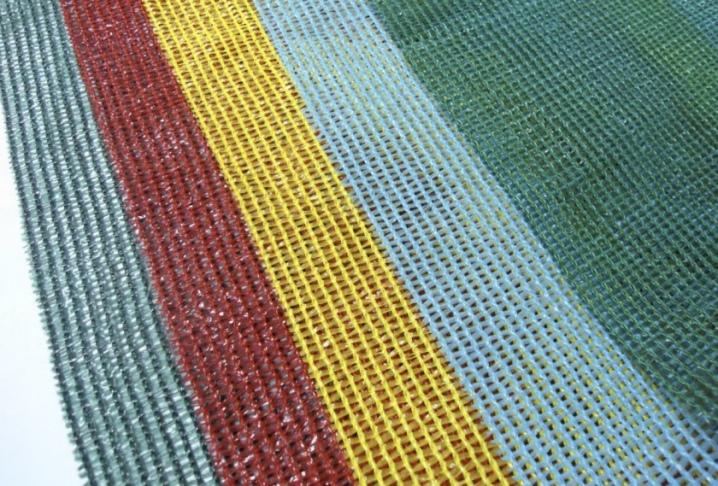
Installation
Before putting on the protection for plants, you need to decide how exactly the shading will be carried out. Fasten the darkening grid from the bottom (from the base of the greenhouse). In the absence of special fasteners, wire or rope is used.
If the shade has a reinforced edge with holes for wire, it is equipped with a nylon cord or a non-fading rope. They are used to fix the network. It is easier to install the mesh together.
The fastening of the material is carried out with an equal pitch, preventing the network from sagging.
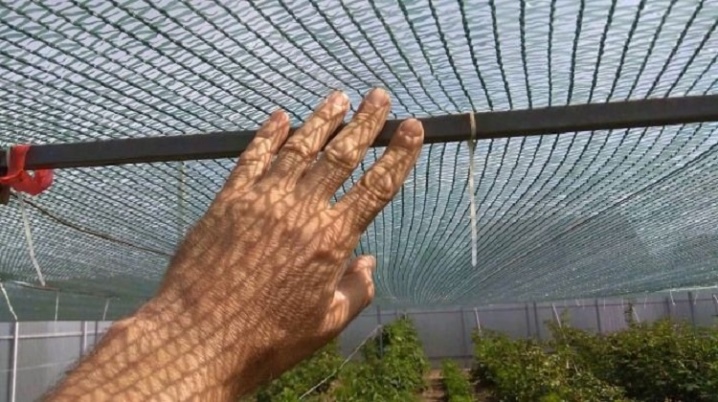
If necessary, use a construction stapler... If the purchased panel does not reach the ground, you can hang small weights on the tension rings. This should be done at equal intervals.
Depending on the type of installation, it can be installed on top of the foil or stretched inside the greenhouse. Installation time may depend on climatic conditions and purpose... For example, in the southern regions of the country, shading is done at the end of May, and is removed in September.
If the greenhouse is made of metal, you can fasten the material around the perimeter with a thread and plastic ties.If it is made of wood, it is better to use narrow planks or nails. In this case, these mounts will be more reliable. Depending on the situation, you can also choose special reusable clips as fasteners.
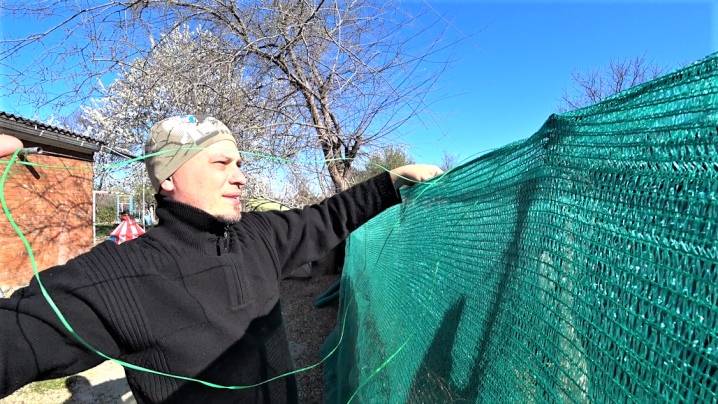
The mesh is attached to supports (for example, elements of the greenhouse frame), fence posts. Depending on the type, if necessary, it is sewn together. The fastening must be strong, otherwise the material will sag and will not last long. For greater reliability, it is recommended to fix the mesh every 10-15 cm.





























































The comment was sent successfully.